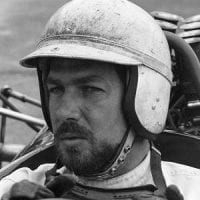It is ironic that someone so committed to promoting safety in this most unsafe of sports should die in what was probably the final season of his long career. A one-time Grand Prix winner, Jo Bonnier was the influential President of the Grand Prix Drivers’ Association who campaigned tirelessly to improve circuits.
National service and early career
He had competed in a rally in 1948 but three years in the Swedish Navy delayed his racing ambitions. Bonnier drove an Alfa Romeo in ice racing and rallies after completing his national service and he turned professional in 1956. That was in a 1500cc Maserati sports car before he made his GP debut when relieving Luigi Villoresi in that year’s Italian GP in a works 250F.
Grand Prix winner for BRM
Two years in a private Maserati 250F ended with a couple of drives for the thus-far unsuccessful BRM team at the end of 1958. Fourth in the Moroccan GP, he remained with the team for the next two seasons and the combination of the journeyman driver and unsuccessful team turned to gold on one occasion. Bonnier qualified for the 1959 Dutch GP in pole position and beat Jack Brabham to score a first GP victory for driver and marque alike.
Bonnier led for much of the Argentine GP at the start of 1960 but could not repeat his Dutch triumph again. Further success was in other forms of the sport when a works Porsche driver. He won Formula 2 races at the Nürburgring (that year’s German GP) and Modena as well as the Targa Florio during 1960. That led to the next couple of F1 seasons being spent with Porsche but fifth would be his best result as he was generally unable to match team-mate Dan Gurney. Stirling Moss no less tipped him for the 1961 title but Bonnier’s long F1 career was on a gradual decline.
Formula 1 privateer
Porsche withdrew from F1 at the end of 1962 but Bonnier continued. That was initially with Rob Walker’s private concern (1963 to 1965) before he ran his own team. Tangible results were limited however and much of 1969 was lost when he crashed during practice for the Oulton Park Gold Cup. Bonnier’s suspension failed at approximately 120mph and he was knocked unconscious when his helmet was ripped off in the violent accident that followed. When he finally retired from F1 in 1971, Bonnier hung his last such car (a McLaren M7C-Ford) on the wall of his house in Switzerland.
Sports car success
If F1 results were hard to come by, he was increasingly successful in sports cars during the 1960s. He won the 1962 Sebring 12 Hours for Ferrari before adding another Targa Florio victory with Porsche’s RS62 a year later. He shared a Maranello Concessionaires Ferrari with Graham Hill in selected 1964 sports car events – finishing second at Le Mans and winning both at Reims and in Montlhéry’s Paris 1000Kms.
The 1966 Nürburgring 1000Kms was Bonnier’s last victory in the World Sportscar Championship and the first European success for Chaparral. His Lola T210-Ford won the 1970 2000cc European Sportscar Championship and he represented both Lola and Hewland in Europe alongside his racing career.
Bonnier’s Lola T290-Cosworth led the 1972 Le Mans 24 Hours early in the race. He had dropped to eighth by morning when he collided with a slower Ferrari Daytona approaching Indianapolis Corner. Launched into the trees, this influential and opinionated veteran was killed instantly.


